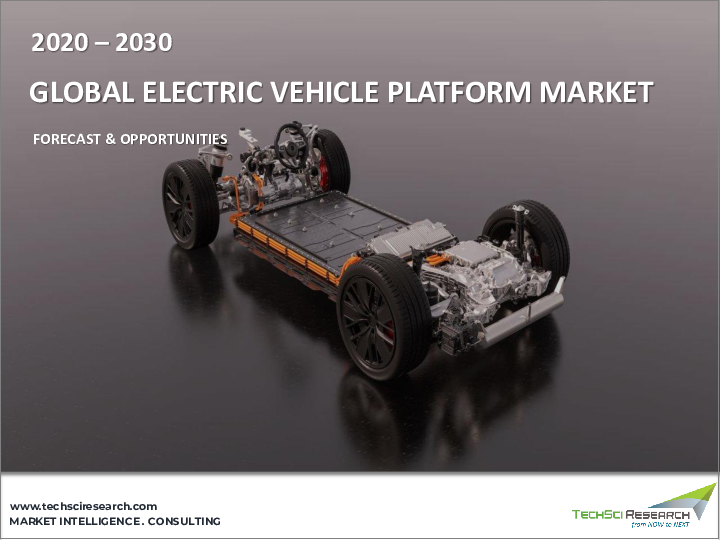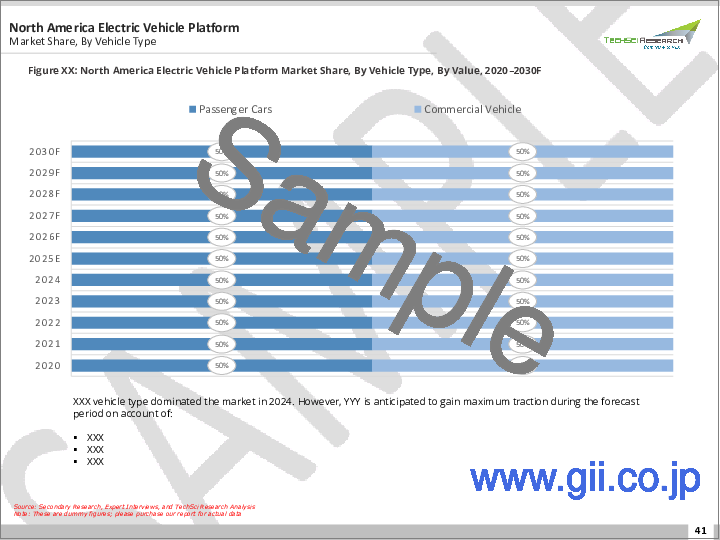|
|
市場調査レポート
商品コード
1807324
電気自動車プラットフォーム市場- 世界の産業規模、シェア、動向、機会、予測、車両タイプ別、推進タイプ別、コンポーネント別、地域別、競合市場別、2020-2030年Electric Vehicle Platform Market- Global Industry Size, Share, Trends, Opportunity, and Forecast, Segmented By Vehicle Type, By Propulsion Type, By Component, By Region & Competition, 2020-2030F |
||||||
カスタマイズ可能
|
|||||||
| 電気自動車プラットフォーム市場- 世界の産業規模、シェア、動向、機会、予測、車両タイプ別、推進タイプ別、コンポーネント別、地域別、競合市場別、2020-2030年 |
|
出版日: 2025年08月31日
発行: TechSci Research
ページ情報: 英文 185 Pages
納期: 2~3営業日
|
全表示
- 概要
- 目次
電気自動車プラットフォームの世界市場規模は2024年に161億5,000万米ドルで、予測期間中のCAGRは18.31%で2030年には442億9,000万米ドルに達すると予測されています。
世界の電気自動車プラットフォーム市場は、持続可能なモビリティへのシフト、バッテリー技術の進歩、メーカーが単一プラットフォームで複数の車種を生産できるスケーラブルなアーキテクチャへの投資の増加により、力強い勢いを見せています。自動車メーカーは、性能、安全性、エネルギー効率を高めるため、軽量素材、構造的完全性の向上、モジュール設計に注力しています。航続距離の延長と高速充電機能に対する消費者の需要の高まりは、固体電池、高電圧システム、高度な熱管理ソリューションの統合を促しています。充電インフラの拡大も、航続距離への不安を軽減し、日常使用と長距離使用の両方における電気自動車の実用性を高めることで需要を押し上げています。例えば、2024年には世界の公共EV充電ネットワークが130万ポイント以上拡大し、前年比30%増となりました。中国はこの成長の約3分の2を占め、現在、世界の公共充電器の約65%を保有し、小型電気自動車ストックの60%を占めています。欧州の公共充電ポイントは2024年に35%以上増加し、100万ポイントを突破しました。
| 市場概要 | |
|---|---|
| 予測期間 | 2026-2030 |
| 市場規模:2024年 | 161億5,000万米ドル |
| 市場規模:2030年 | 442億9,000万米ドル |
| CAGR:2025年~2030年 | 18.31% |
| 急成長セグメント | 乗用車 |
| 最大市場 | アジア太平洋 |
市場促進要因
モジュラー型車両アーキテクチャに対する需要の高まり
主な市場課題
高い開発・生産コスト
主な市場動向
最大限の柔軟性を実現するスケートボードのシャーシ設計
目次
第1章 イントロダクション
第2章 調査手法
第3章 エグゼクティブサマリー
第4章 世界の電気自動車プラットフォーム市場展望
- 市場規模・予測
- 金額別
- 市場シェア・予測
- 車種別(乗用車、商用車)
- 推進タイプ別(BEV、HEV、PHEV、FCEV)
- コンポーネント別(サスペンション、ステアリング、モーター、ブレーキ、シャーシ、ECU、バッテリー)
- 地域別
- 企業別(2024)
- 市場マップ
第5章 北米の電気自動車プラットフォーム市場展望
- 市場規模・予測
- 金額別
- 市場シェア・予測
- 車両タイプ別
- 推進タイプ別
- コンポーネント別
- 国別
- 北米:国別分析
- 米国
- カナダ
- メキシコ
第6章 欧州・CISの電気自動車プラットフォーム市場展望
- 市場規模・予測
- 市場シェア・予測
- 欧州・CIS:国別分析
- フランス
- ドイツ
- スペイン
- イタリア
- 英国
第7章 アジア太平洋地域の電気自動車プラットフォーム市場展望
- 市場規模・予測
- 市場シェア・予測
- アジア太平洋地域:国別分析
- 中国
- 日本
- インド
- ベトナム
- 韓国
- オーストラリア
- タイ
第8章 中東・アフリカの電気自動車プラットフォーム市場展望
- 市場規模・予測
- 市場シェア・予測
- 中東・アフリカ:国別分析
- 南アフリカ
- サウジアラビア
- アラブ首長国連邦
- トルコ
第9章 南米の電気自動車プラットフォーム市場展望
- 市場規模・予測
- 市場シェア・予測
- 南米:国別分析
- ブラジル
- アルゼンチン
- コロンビア
第10章 市場力学
- 促進要因
- 課題
第11章 主要な市場の混乱
- 紛争
- パンデミック
- 貿易障壁
第12章 市場動向と発展
第13章 政策と規制状況
第14章 競合情勢
- 企業プロファイル
- Tesla
- BYD Auto
- Tata Motors
- Volkswagen Group
- SAIC Motor
- Hyundai Motor Group
- General Motors
- Ford Motor Company
- Stellantis
- Toyota Motor Corporation
第15章 戦略的提言
第16章 調査会社について・免責事項
Global Electric Vehicle Platform Market was valued at USD 16.15 Billion in 2024 and is expected to reach USD 44.29 Billion by 2030 with a CAGR of 18.31% during the forecast period. The global electric vehicle platform market is experiencing robust momentum driven by the shift toward sustainable mobility, advancements in battery technology, and rising investments in scalable architectures that enable manufacturers to produce multiple vehicle models on a single platform. Automakers are focusing on lightweight materials, improved structural integrity, and modular designs to enhance performance, safety, and energy efficiency. Growing consumer demand for extended driving ranges and faster charging capabilities is prompting the integration of solid-state batteries, high-voltage systems, and advanced thermal management solutions. Expanding charging infrastructure is also boosting demand by reducing range anxiety and increasing the practicality of electric vehicles for both daily and long-distance use. For instance, in 2024, the global public EV charging network expanded by over 1.3 million points, a 30% year-over-year increase. China accounted for about two-thirds of this growth and currently holds approximately 65% of global public chargers alongside 60% of the electric light-duty vehicle stock. Europe's public charging points grew by more than 35% in 2024, surpassing 1 million points, with the Netherlands leading Europe's network with over 180,000 chargers.
| Market Overview | |
|---|---|
| Forecast Period | 2026-2030 |
| Market Size 2024 | USD 16.15 Billion |
| Market Size 2030 | USD 44.29 Billion |
| CAGR 2025-2030 | 18.31% |
| Fastest Growing Segment | Passenger Cars |
| Largest Market | Asia Pacific |
Market Drivers
Rising Demand for Modular Vehicle Architectures
Automakers are increasingly adopting modular electric vehicle platforms that can accommodate various body styles and powertrain configurations, enabling flexible production and reduced manufacturing costs. These architectures allow manufacturers to scale production across different vehicle segments without redesigning from scratch, saving both time and resources. Modular designs enhance adaptability for evolving battery technologies and performance upgrades, allowing rapid incorporation of improvements in energy density, charging systems, and connectivity features. This flexibility helps OEMs meet diverse consumer needs, from compact urban EVs to high-performance SUVs, using shared structural components. The efficiency in production planning, supply chain management, and inventory control creates a competitive advantage while supporting sustainability goals.
Key Market Challenges
High Development and Production Costs
Designing and manufacturing advanced electric vehicle platforms involves substantial investment in research, engineering, and specialized production facilities. The need for lightweight materials, high-performance battery integration, and adaptable architectures requires complex engineering solutions that raise costs during initial development. These expenses are further amplified by the requirement to meet stringent safety, efficiency, and environmental standards, which often necessitate advanced testing and certification processes. For many manufacturers, especially new entrants, these costs create significant barriers to scaling production and achieving profitability. Even for established OEMs, balancing the investment between electric vehicle platforms and existing internal combustion engine lines can strain resources.
Key Market Trends
Skateboard Chassis Design for Maximum Flexibility
The skateboard chassis concept, where the battery pack and essential drivetrain components are integrated into a flat, floor-mounted platform, is gaining momentum as a defining trend in electric vehicle platform development. This design allows for a low center of gravity, improved weight distribution, and greater cabin space efficiency. The flat and modular nature of the skateboard platform enables manufacturers to adapt the same base to various vehicle types, from sedans to SUVs to light commercial vehicles, with minimal re-engineering. This approach accelerates time-to-market for new models while reducing production costs through shared components and assembly processes. It also supports the integration of larger battery packs for extended ranges without compromising vehicle proportions. The skateboard platform's structural efficiency enhances crash safety and makes it easier to incorporate advanced driver-assistance and autonomous systems.
Key Market Players
- Tesla
- BYD Auto
- Tata Motors
- Volkswagen Group
- SAIC Motor
- Hyundai Motor Group
- General Motors
- Ford Motor Company
- Stellantis
- Toyota Motor Corporation
Report Scope:
In this report, the global Electric Vehicle Platform Market has been segmented into the following categories, in addition to the industry trends which have also been detailed below:
Electric Vehicle Platform Market, By Vehicle Type:
- Passenger Cars
- Commercial Vehicle
Electric Vehicle Platform Market, By Propulsion Type:
- BEV
- HEV
- PHEV
- FCEV
Electric Vehicle Platform Market, By Component:
- Suspension
- Steering
- Motor
- Brake
- Chassis
- ECU
- Battery
Electric Vehicle Platform Market, By Region:
- North America
- United States
- Canada
- Mexico
- Europe & CIS
- Germany
- France
- U.K.
- Spain
- Italy
- Asia-Pacific
- China
- Japan
- India
- Vietnam
- South Korea
- Australia
- Thailand
- Middle East & Africa
- South Africa
- Saudi Arabia
- UAE
- Turkey
- South America
- Brazil
- Argentina
- Colombia
Competitive Landscape
Company Profiles: Detailed analysis of the major companies presents in the global Electric Vehicle Platform Market.
Available Customizations:
Global Electric Vehicle Platform Market report with the given market data, TechSci Research offers customizations according to the company's specific needs. The following customization options are available for the report:
Company Information
- Detailed analysis and profiling of additional market players (up to five).
Table of Contents
1. Introduction
- 1.1. Product Overview
- 1.2. Key Highlights of the Report
- 1.3. Market Coverage
- 1.4. Market Segments Covered
- 1.5. Research Tenure Considered
2. Research Methodology
- 2.1. Methodology Landscape
- 2.2. Objective of the Study
- 2.3. Baseline Methodology
- 2.4. Formulation of the Scope
- 2.5. Assumptions and Limitations
- 2.6. Sources of Research
- 2.7. Approach for the Market Study
- 2.8. Methodology Followed for Calculation of Market Size & Market Shares
- 2.9. Forecasting Methodology
3. Executive Summary
- 3.1. Overview of the Market
- 3.2. Overview of Key Market Segmentations
- 3.3. Overview of Key Market Players
- 3.4. Overview of Key Regions
- 3.5. Overview of Market Drivers, Challenges, and Trends
4. Global Electric Vehicle Platform Market Outlook
- 4.1. Market Size & Forecast
- 4.1.1. By Value
- 4.2. Market Share & Forecast
- 4.2.1. By Vehicle Type (Passenger Cars, Commercial Vehicle)
- 4.2.2. By Propulsion Type (BEV, HEV, PHEV, FCEV)
- 4.2.3. By Component (Suspension, Steering, Motor, Brake, Chassis, ECU, Battery)
- 4.2.4. By Region
- 4.2.5. By Company (2024)
- 4.3. Market Map
5. North America Electric Vehicle Platform Market Outlook
- 5.1. Market Size & Forecast
- 5.1.1. By Value
- 5.2. Market Share & Forecast
- 5.2.1. By Vehicle Type
- 5.2.2. By Propulsion Type
- 5.2.3. By Component
- 5.2.4. By Country
- 5.3. North America: Country Analysis
- 5.3.1. United States Electric Vehicle Platform Market Outlook
- 5.3.1.1. Market Size & Forecast
- 5.3.1.1.1. By Value
- 5.3.1.2. Market Share & Forecast
- 5.3.1.2.1. By Vehicle Type
- 5.3.1.2.2. By Propulsion Type
- 5.3.1.2.3. By Component
- 5.3.1.1. Market Size & Forecast
- 5.3.2. Canada Electric Vehicle Platform Market Outlook
- 5.3.2.1. Market Size & Forecast
- 5.3.2.1.1. By Value
- 5.3.2.2. Market Share & Forecast
- 5.3.2.2.1. By Vehicle Type
- 5.3.2.2.2. By Propulsion Type
- 5.3.2.2.3. By Component
- 5.3.2.1. Market Size & Forecast
- 5.3.3. Mexico Electric Vehicle Platform Market Outlook
- 5.3.3.1. Market Size & Forecast
- 5.3.3.1.1. By Value
- 5.3.3.2. Market Share & Forecast
- 5.3.3.2.1. By Vehicle Type
- 5.3.3.2.2. By Propulsion Type
- 5.3.3.2.3. By Component
- 5.3.3.1. Market Size & Forecast
- 5.3.1. United States Electric Vehicle Platform Market Outlook
6. Europe & CIS Electric Vehicle Platform Market Outlook
- 6.1. Market Size & Forecast
- 6.1.1. By Value
- 6.2. Market Share & Forecast
- 6.2.1. By Vehicle Type
- 6.2.2. By Propulsion Type
- 6.2.3. By Component
- 6.2.4. By Country
- 6.3. Europe & CIS: Country Analysis
- 6.3.1. France Electric Vehicle Platform Market Outlook
- 6.3.1.1. Market Size & Forecast
- 6.3.1.1.1. By Value
- 6.3.1.2. Market Share & Forecast
- 6.3.1.2.1. By Vehicle Type
- 6.3.1.2.2. By Propulsion Type
- 6.3.1.2.3. By Component
- 6.3.1.1. Market Size & Forecast
- 6.3.2. Germany Electric Vehicle Platform Market Outlook
- 6.3.2.1. Market Size & Forecast
- 6.3.2.1.1. By Value
- 6.3.2.2. Market Share & Forecast
- 6.3.2.2.1. By Vehicle Type
- 6.3.2.2.2. By Propulsion Type
- 6.3.2.2.3. By Component
- 6.3.2.1. Market Size & Forecast
- 6.3.3. Spain Electric Vehicle Platform Market Outlook
- 6.3.3.1. Market Size & Forecast
- 6.3.3.1.1. By Value
- 6.3.3.2. Market Share & Forecast
- 6.3.3.2.1. By Vehicle Type
- 6.3.3.2.2. By Propulsion Type
- 6.3.3.2.3. By Component
- 6.3.3.1. Market Size & Forecast
- 6.3.4. Italy Electric Vehicle Platform Market Outlook
- 6.3.4.1. Market Size & Forecast
- 6.3.4.1.1. By Value
- 6.3.4.2. Market Share & Forecast
- 6.3.4.2.1. By Vehicle Type
- 6.3.4.2.2. By Propulsion Type
- 6.3.4.2.3. By Component
- 6.3.4.1. Market Size & Forecast
- 6.3.5. United Kingdom Electric Vehicle Platform Market Outlook
- 6.3.5.1. Market Size & Forecast
- 6.3.5.1.1. By Value
- 6.3.5.2. Market Share & Forecast
- 6.3.5.2.1. By Vehicle Type
- 6.3.5.2.2. By Propulsion Type
- 6.3.5.2.3. By Component
- 6.3.5.1. Market Size & Forecast
- 6.3.1. France Electric Vehicle Platform Market Outlook
7. Asia-Pacific Electric Vehicle Platform Market Outlook
- 7.1. Market Size & Forecast
- 7.1.1. By Value
- 7.2. Market Share & Forecast
- 7.2.1. By Vehicle Type
- 7.2.2. By Propulsion Type
- 7.2.3. By Component
- 7.2.4. By Country
- 7.3. Asia-Pacific: Country Analysis
- 7.3.1. China Electric Vehicle Platform Market Outlook
- 7.3.1.1. Market Size & Forecast
- 7.3.1.1.1. By Value
- 7.3.1.2. Market Share & Forecast
- 7.3.1.2.1. By Vehicle Type
- 7.3.1.2.2. By Propulsion Type
- 7.3.1.2.3. By Component
- 7.3.1.1. Market Size & Forecast
- 7.3.2. Japan Electric Vehicle Platform Market Outlook
- 7.3.2.1. Market Size & Forecast
- 7.3.2.1.1. By Value
- 7.3.2.2. Market Share & Forecast
- 7.3.2.2.1. By Vehicle Type
- 7.3.2.2.2. By Propulsion Type
- 7.3.2.2.3. By Component
- 7.3.2.1. Market Size & Forecast
- 7.3.3. India Electric Vehicle Platform Market Outlook
- 7.3.3.1. Market Size & Forecast
- 7.3.3.1.1. By Value
- 7.3.3.2. Market Share & Forecast
- 7.3.3.2.1. By Vehicle Type
- 7.3.3.2.2. By Propulsion Type
- 7.3.3.2.3. By Component
- 7.3.3.1. Market Size & Forecast
- 7.3.4. Vietnam Electric Vehicle Platform Market Outlook
- 7.3.4.1. Market Size & Forecast
- 7.3.4.1.1. By Value
- 7.3.4.2. Market Share & Forecast
- 7.3.4.2.1. By Vehicle Type
- 7.3.4.2.2. By Propulsion Type
- 7.3.4.2.3. By Component
- 7.3.4.1. Market Size & Forecast
- 7.3.5. South Korea Electric Vehicle Platform Market Outlook
- 7.3.5.1. Market Size & Forecast
- 7.3.5.1.1. By Value
- 7.3.5.2. Market Share & Forecast
- 7.3.5.2.1. By Vehicle Type
- 7.3.5.2.2. By Propulsion Type
- 7.3.5.2.3. By Component
- 7.3.5.1. Market Size & Forecast
- 7.3.6. Australia Electric Vehicle Platform Market Outlook
- 7.3.6.1. Market Size & Forecast
- 7.3.6.1.1. By Value
- 7.3.6.2. Market Share & Forecast
- 7.3.6.2.1. By Vehicle Type
- 7.3.6.2.2. By Propulsion Type
- 7.3.6.2.3. By Component
- 7.3.6.1. Market Size & Forecast
- 7.3.7. Thailand Electric Vehicle Platform Market Outlook
- 7.3.7.1. Market Size & Forecast
- 7.3.7.1.1. By Value
- 7.3.7.2. Market Share & Forecast
- 7.3.7.2.1. By Vehicle Type
- 7.3.7.2.2. By Propulsion Type
- 7.3.7.2.3. By Component
- 7.3.7.1. Market Size & Forecast
- 7.3.1. China Electric Vehicle Platform Market Outlook
8. Middle East & Africa Electric Vehicle Platform Market Outlook
- 8.1. Market Size & Forecast
- 8.1.1. By Value
- 8.2. Market Share & Forecast
- 8.2.1. By Vehicle Type
- 8.2.2. By Propulsion Type
- 8.2.3. By Component
- 8.2.4. By Country
- 8.3. MEA: Country Analysis
- 8.3.1. South Africa Electric Vehicle Platform Market Outlook
- 8.3.1.1. Market Size & Forecast
- 8.3.1.1.1. By Value
- 8.3.1.2. Market Share & Forecast
- 8.3.1.2.1. By Vehicle Type
- 8.3.1.2.2. By Propulsion Type
- 8.3.1.2.3. By Component
- 8.3.1.1. Market Size & Forecast
- 8.3.2. Saudi Arabia Electric Vehicle Platform Market Outlook
- 8.3.2.1. Market Size & Forecast
- 8.3.2.1.1. By Value
- 8.3.2.2. Market Share & Forecast
- 8.3.2.2.1. By Vehicle Type
- 8.3.2.2.2. By Propulsion Type
- 8.3.2.2.3. By Component
- 8.3.2.1. Market Size & Forecast
- 8.3.3. UAE Electric Vehicle Platform Market Outlook
- 8.3.3.1. Market Size & Forecast
- 8.3.3.1.1. By Value
- 8.3.3.2. Market Share & Forecast
- 8.3.3.2.1. By Vehicle Type
- 8.3.3.2.2. By Propulsion Type
- 8.3.3.2.3. By Component
- 8.3.3.1. Market Size & Forecast
- 8.3.4. Turkey Electric Vehicle Platform Market Outlook
- 8.3.4.1. Market Size & Forecast
- 8.3.4.1.1. By Value
- 8.3.4.2. Market Share & Forecast
- 8.3.4.2.1. By Vehicle Type
- 8.3.4.2.2. By Propulsion Type
- 8.3.4.2.3. By Component
- 8.3.4.1. Market Size & Forecast
- 8.3.1. South Africa Electric Vehicle Platform Market Outlook
9. South America Electric Vehicle Platform Market Outlook
- 9.1. Market Size & Forecast
- 9.1.1. By Value
- 9.2. Market Share & Forecast
- 9.2.1. By Vehicle Type
- 9.2.2. By Propulsion Type
- 9.2.3. By Component
- 9.2.4. By Country
- 9.3. South America: Country Analysis
- 9.3.1. Brazil Electric Vehicle Platform Market Outlook
- 9.3.1.1. Market Size & Forecast
- 9.3.1.1.1. By Value
- 9.3.1.2. Market Share & Forecast
- 9.3.1.2.1. By Vehicle Type
- 9.3.1.2.2. By Propulsion Type
- 9.3.1.2.3. By Component
- 9.3.1.1. Market Size & Forecast
- 9.3.2. Argentina Electric Vehicle Platform Market Outlook
- 9.3.2.1. Market Size & Forecast
- 9.3.2.1.1. By Value
- 9.3.2.2. Market Share & Forecast
- 9.3.2.2.1. By Vehicle Type
- 9.3.2.2.2. By Propulsion Type
- 9.3.2.2.3. By Component
- 9.3.2.1. Market Size & Forecast
- 9.3.3. Colombia Electric Vehicle Platform Market Outlook
- 9.3.3.1. Market Size & Forecast
- 9.3.3.1.1. By Value
- 9.3.3.2. Market Share & Forecast
- 9.3.3.2.1. By Vehicle Type
- 9.3.3.2.2. By Propulsion Type
- 9.3.3.2.3. By Component
- 9.3.3.1. Market Size & Forecast
- 9.3.1. Brazil Electric Vehicle Platform Market Outlook
10. Market Dynamics
- 10.1. Drivers
- 10.2. Challenges
11. Key Market Disruptions
- 11.1. Conflicts
- 11.2. Pandemic
- 11.3. Trade Barriers
12. Market Trends & Developments
13. Policy & Regulatory Landscape
14. Competitive Landscape
- 14.1. Company Profiles
- 14.1.1. Tesla
- 14.1.1.1. Business Overview
- 14.1.1.2. Company Snapshot
- 14.1.1.3. Products & Services
- 14.1.1.4. Financials (As Per Availability)
- 14.1.1.5. Key Market Focus & Geographical Presence
- 14.1.1.6. Recent Developments
- 14.1.1.7. Key Management Personnel
- 14.1.2. BYD Auto
- 14.1.3. Tata Motors
- 14.1.4. Volkswagen Group
- 14.1.5. SAIC Motor
- 14.1.6. Hyundai Motor Group
- 14.1.7. General Motors
- 14.1.8. Ford Motor Company
- 14.1.9. Stellantis
- 14.1.10. Toyota Motor Corporation
- 14.1.1. Tesla




